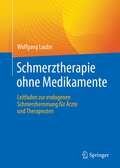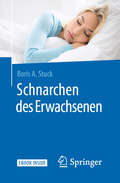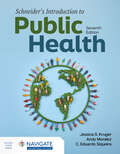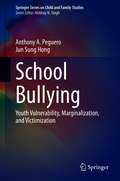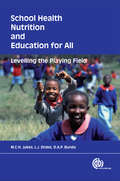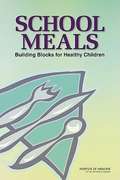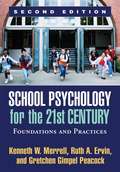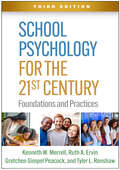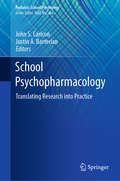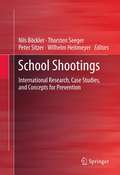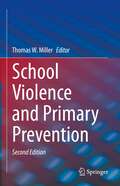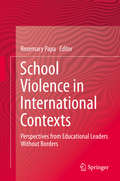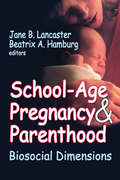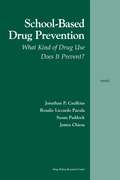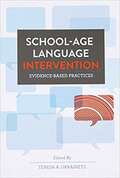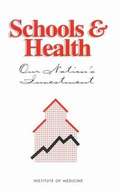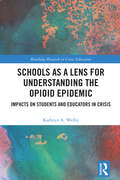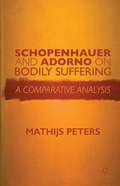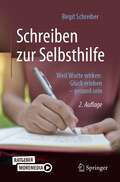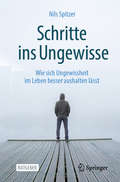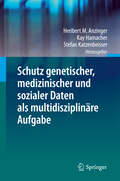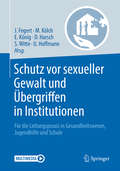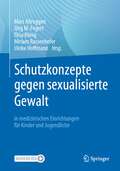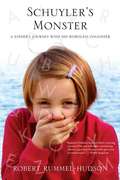- Table View
- List View
Schmerztherapie ohne Medikamente: Leitfaden zur endogenen Schmerzhemmung für Ärzte und Therapeuten
by Wolfgang LaubeDie regulative Schmerztherapie ist mit ihren physiologisch begründeten aufeinanderfolgenden Interventionen spezifisch auf die Verhinderung der Entwicklung bzw. die Behandlung von chronischen Schmerzen ausgerichtet. In diesem Buch wird je nach notwendiger Indikation die gesamte nicht pharmakologische Therapiekette der möglichen Interventionen vorgestellt. Es werden dabei sowohl passiv provozierte funktionell begründete Maßnahmen zur Aktivierung der Schmerzhemmmechanismen und der Durchblutungsförderung zur Verbesserung der Gewebeverhältnisse als Grundlage nozizeptiver Informationen beschrieben, als auch aktive Methoden, z.B. das antinozizeptive endgradige Beweglichkeitstraining von Gelenkregionen und andere aktive Belastungsinterventionen mit dem Ziel, eine strukturelle und funktionelle anti-nozizeptive Reorganisation auszulösen. Das Buch ist somit ein guter Leitfaden für die nicht-medikamentöse Schmerztherapie und die medizinische Rehabilitation aller primär und sekundär chronisch-degenerativen und entzündlichen Erkrankungen aber auch von onkologischen Erkrankungen. Als Zielgruppe werden Ärzte, Physiotherapeuten aber auch Sporttherapeuten angesprochen, die Schmerzpatienten betreuen.
Schnarchen des Erwachsenen
by Boris A. StuckSchnarchen ist weit verbreitet und vermeintlich jedem geläufig – doch ist das Schnarchen wirklich nur „lästig“ für den Bettpartner? Wie ist die Abgrenzung zu anderen Schlafstörungen? Wann und wie sollte es behandelt werden? Dieses Buch bietet das Praxiswissen für die tägliche Arbeit Grundlagen, PathophysiologieDifferenzierte Diagnostikkurz-, mittel- und langfristige TherapiemöglichkeitenIndikation zu einer Überweisung an einen Spezialisten/Schlafmediziner Entsprechend der S3-Leitlinie „Diagnostik und Therapie des Schnarchens des Erwachsenen“. Alles, was wichtig, häufig und klinisch relevant ist. Für Schlafmediziner, Internisten, Allgemeinmediziner, HNO-Ärzte und alle Therapeuten, die mit der Diagnostik und Therapie des Schnarchens befasst sind.
Schneider's Introduction to Public Health with Navigate Advantage Access
by Jessica Kruger Andy Moralez C. Eduardo SiqueiraOffering a thorough, accessible and lively overview of public health for students new to the field, Schneider’s Introduction to Public Health offers a broad-reaching, practical framework for understanding the forces and organizations of public health today. Through engaging, nontechnical language, illustrative real-world examples, and the current political, economic, and cultural news of the day, students gain a clear understanding of the scope of today's public health problems and possible solutions. Building on Mary-Jane Schneider’s engaging and easy-to-read narrative approach, new author team Kruger, Moralez, and Siqueira draw on their diverse perspectives for the Seventh Edition to bring a greater focus on the social determinants of health, ecological approach, and life course experiences as a framework to understand public health in the 21st century.
School Bullying: Youth Vulnerability, Marginalization, and Victimization (Springer Series on Child and Family Studies)
by Anthony A. Peguero Jun Sung HongThis book examines the associated experiences of school bullying and violence among vulnerable and marginalized youth. It discusses the effects of diversity and disparities in youth’s experiences with bullying. Among these are socioeconomic and social status, family cohesion and interactions, sex, sexual orientation, gender identity and gender expression, race, ethnicity, immigration, religion, and disabilities and special health needs. The book describes the ways in which a social-ecological framework can inform the problem and address school bullying. It addresses not only individual, intrapersonal, and environmental factors of bullying, but also discusses distal level factors and conditions that are specifically relevant to youth (e.g., culture and law). In addition, this volume contextualizes relevant multilevel factors that foster or inhibit bullying victimization among vulnerable and historically marginalized children and adolescents who are faced with cumulative social stratification. Key areas of coverage include: The role of the family (parents and guardians, siblings) – its cohesion and interactions – in school bullying.Race, ethnicity, immigration, and religion and school bullying of marginalized and at-risk youth.Victimization of students with physical, emotional, and learning disorders.Bullying and victimization of vulnerable youth in the court systems. School Bullying is an essential resource for researchers, clinicians and other practitioners, graduate students, and policymakers across such disciplines as child and school psychology, social work and counseling, pediatrics and school nursing, educational policy and politics, and all interrelated disciplines.
School Health, Nutrition, and Education for All: Levelling the Playing Field
by Matthew C. H. Jukes Lesley J. Drake Donald A. P. BundyProviding good quality education to all children in the poorest countries of the world is not a simple task. However, improving children's health and nutrition is one simple step that can be taken towards achieving this goal. Health and nutrition programs offer substantial benefits to children's education, helping them to attend school and learn while there. What is more, the education of the poorest in society benefits the most from such programs because the poor are more likely to suffer from ill health or poor nutrition and are also more likely to experience a disruption in their learning as a result. School health and nutrition programs make use of the education system to deliver simple treatments for common conditions. The result is a highly cost-effective way to reduce inequalities in education and to help all children around the world reach their educational potential. This argument is examined through a discussion of the challenges to child health and nutrition and the impact of these on education and an analysis of the costs, benefits and policy options involved in the implementation of health and nutrition programs in schools. Providing a simple and achievable solution to improving access, gender equity and the quality of basic education, this book will be essential to policy makers, educational and health organizations and researchers in international development, public health, psychology and education.
School Meals: Building Blocks for Healthy Children
by Institute of MedicineEnsuring that the food provided to children in schools is consistent with current dietary recommendations is an important national focus. Various laws and regulations govern the operation of school meal programs. In 1995, Nutrition Standards and Meal Requirements were put in place to ensure that all meals offered would be high in nutritional quality. School Meals reviews and provides recommendations to update the nutrition standard and the meal requirements for the National School Breakfast and Lunch Programs. The recommendations reflect new developments in nutrition science, increase the availability of key food groups in the school meal programs, and allow these programs to better meet the nutritional needs of children, foster healthy eating habits, and safeguard children's health. School Meals sets standards for menu planning that focus on food groups, calories, saturated fat, and sodium and that incorporate Dietary Guidelines for Americans and the Dietary Reference Intakes. This book will be used as a guide for school food authorities, food producers, policy leaders, state/local governments, and parents.
School Psychology for the 21st Century, Second Edition
by Kenneth W. Merrell Ruth A. ErvinA leading introductory text, this authoritative volume comprehensively describes the school psychologist's role in promoting positive academic, behavioral, and emotional outcomes for all students. The book emphasizes a problem-solving-based, data-driven approach to practice in today's diverse schools. It grounds the reader in the concepts and tools needed to become a competent, ethical practitioner; implement and evaluate multi-tiered interventions; and facilitate systems-level change. Useful pedagogical features include illustrative vignettes and end-of-chapter discussion questions and activities. New to This Edition *Incorporates up-to-date research findings and professional standards. Expanded coverage of response to intervention, cultural and linguistic diversity issues, and evidence-based practice in mental health. Chapter on legal issues includes expanded coverage of IDEIA and other recent federal mandates.
School Psychology for the 21st Century, Third Edition: Foundations and Practices
by Kenneth W. Merrell Ruth A. Ervin Gretchen Gimpel Peacock Tyler L. RenshawNow in a revised and updated third edition reflecting a decade of changes in the field, this leading text prepares new practitioners to support all students' academic, behavioral, and social–emotional success. The multiple roles and functions of the school psychologist are described and illustrated with vivid vignettes. Readers gain vital skills for planning and implementing evidence-based prevention and intervention efforts and collaborating to facilitate systems change. Guided by a problem-solving perspective, the book provides tools for effective, culturally responsive practice in today's diverse schools. End-of-chapter discussion questions and activities enhance learning. New to This Edition *Incorporates key advances in evidence-based assessment, intervention, and multi-tiered systems of support. *Increased attention to supporting the growing numbers of culturally and linguistically diverse students in schools. *Addresses changes in school psychology training programs and professional standards. *New emphasis on implementation science.
School Psychopharmacology: Translating Research into Practice (Pediatric School Psychology)
by John S. Carlson Justin A. BarterianThis book provides a research-based overview of the use of psychotropic medications in combination with psychosocial interventions to improve learning, social interactions, and behavioral functioning of children within the school setting. It details implementation strategies for delivering multimodal treatments to school-aged children with psychiatric diagnoses while coordinating services across educational and health service sectors. In addition, it includes case studies on ADHD, conduct disorder, depression, social anxiety, autism spectrum disorder, bipolar disorder, and psychosis, with overviews of treatment plans, targeted goals and behaviors, classroom-based medication evaluation plans, and treatment responses communicated back to the child’s family and physician. The book concludes with an overview of integrated behavioral health and the benefits of care coordination to school-aged children experiencing social, emotional, and behavioral challenges. Topics featured in this text include:Legal, ethical, and professional issues related to the use of psychotropic medications in school-aged populations.Effective medications for treating mood dysregulation disorders in school-aged youth.Medications for internalizing and externalizing disorders.Common side effects of psychotropic medication in school-aged populations.The need to be culturally sensitive when considering treatment plans for school-aged youth. School Psychopharmacology is an essential resource for researchers, graduate students, and other professionals in child and school psychology, social work, psychiatry, psychopharmacology, special and general education, public health, and counseling.
School Shootings
by Wilhelm Heitmeyer Thorsten Seeger Peter Sitzer Nils BöcklerSchool shootings are a topic of research in a variety of different disciplines--from psychology, to sociology to criminology, pedagogy, and public health--each with their own set of theories. Many of these theories are logically interconnected, while some differ widely and seem incompatible with each other, leading to divergent results about potential means of prevention. In this innovative work, leading researchers on the topic of school shootings introduce their findings and theoretical concepts in one combined systematic volume. The contributions to this work highlight both the complementary findings from different fields, as well as cases where they diverge or contradict each other. The work is divided into four main sections: an overview of current theoretical approaches and empirical models; application of these theories to international cases, including Columbine (USA), Emsdetten (Germany), and Tuusula (Finland); a critique of the influence of the media, both in the portrayals of past events and its effect on future events; and finally an overview of existing models for prevention and intervention, and measures of their success. The result is a comprehensive source for current research on school shootings, and will provide a direction for future research.
School Violence and Primary Prevention
by Thomas W. MillerThis important new work covers clinical issues in treating victims of school violence and assessing children with the potential for violence. The editor also examines the effectiveness of prevention intervention programs and offers larger policy recommendations. The book looks at environmental factors such as cultural issues on behaviors from bullying to mass school shootings. And uniquely, the book delves into topics such as sexual boundaries and body image. In all, this book aims for a theoretical and applied picture of the current state of school violence and prevention.
School Violence in International Contexts: Perspectives from Educational Leaders Without Borders
by Rosemary PapaThis international edited volume is a rare look at cultural, economic and political forces that contribute to school violence. In light of the devastating events in US schools and the violence towards students and schools world-wide, the war on knowledge development in non/secular education is increasing at an alarming rate. This book offers an international perspective on violence from both K-12 to tertiary levels, parents, administrators-teachers-support staff and research scholars in a desire to understand the contextual issues surrounding violence and its impacts on the field of education. ELWB Scholars and practitioners hail from six continents propose historical to futuristic perspectives linking violence towards education and its inhabitants while framing future strategies to alter multinational fear mongering to the decline of knowledge generation for an informed citizenry.
School-Age Pregnancy and Parenthood: Biosocial Dimensions
by Beatrix A. HamburgThis important work examines in detail and depth how, as a consequence of changing technologies, diet, patterns of reproduction, and work, relations between children and parents have altered.The editors and contributors hold that biosocial science is particularly relevant to research on human family systems and parenting behavior. The family is the universal social institution in which the care of children is based and the turf where cultural tradition, beliefs, and values are transmitted to the young as they fulfill their biological potential for growth, development and reproduction. The biosocial perspective takes into account the biological substratum and the social environment as critical co-determinants of behavior and pinpoints areas in which contemporary human parental behavior exhibits continuities with and departures from, patterns evident throughout history.This work crosses disciplinary lines without ignoring their relevance to the broader themes of the book. School age pregnancy and parenthood is a powerful anchor for the dissection of large scale issues. The contributors deal in turn with ethnic and historical experience, examine normative and ethical issues, and cast new light on methodological concerns. What the editors call culturally-defined responses to basic needs helps explain both dramatic improvements in this area, and how they expand the challenge of teen reproduction. Contributors emphasize new demands for training and education to research this growing phenomenon. The book contributes to humane concerns as well as the scientific imagination.
School-Based Drug Prevention
by James Chiesa Rosalie Liccardo Pacula Jonathan P. Caulkins Susan M. PaddockSchool-based drug prevention, popular with the public and politicians alike, is now a nearly universal experience for American youth. Analysis has shown that the best programs can reduce use of a wide range of substances. But questions remain regarding how to think about and, hence, fund, these programs. Should they be viewed principally as weapons in the war against illicit drugs, or, at the other extreme, do prevention programs benefit students and society most by reducing use of alcohol and tobacco? The authors address these questions by comparing for the first time the social benefits of school-based prevention programs' long-run impacts on a diverse set of different substances.
School-age Language Intervention: Evidence-based Practices
by Teresa A. UkrainetzSchool-Age Language Intervention: Evidence-based Practices explains how to teach the language and literacy skills, strategies, and underlying processes needed for educational success. This book brings together an array of experts to provide the latest practical and evidence-based guidance to school speech-language pathologists. School-Age Language Intervention shows that the research evidence continues to support the themes of the popular Contextualized Language Intervention: intervention within naturalistic, motivating communicative contexts, using the critical treatment elements of RISE (Repeated opportunities, Intensive schedule, Systematic support, Explicit skill focus). School-age Language Intervention is organized into three sections: Section 1: addresses the fundamentals of school SLP practice: who works on what; the ways treatment can be structured; and the rules of the road that govern special education and SLP services. This section explains evidence-based practice and helps students and clinicians make sense of the complicated world of research evidence. The best of skill-based and naturalistic intervention are combined in a RISE-based whole-part-whole framework. Academic standards, particularly the new Common Core State Standards, are used to link treatment to the classroom. This section ends with critical consideration of specific language impairment and reading disability that includes the latest brain research, and how second-language-learners fare in different instructional and treatment formats. Section 2: details best practices for spoken and written language intervention. Chapters address how to effectively teach diverse and deep vocabulary knowledge, complex syntactic skills, and the narrative and informational discourse needed to understand and produce academic texts. A chapter is devoted to helping children at environmental risk to cope with the expectations of school. Section 3: addresses the written code and the cognitive underpinnings of school success: phonological processing, word identification, reading fluency, and spelling. Language and print demands come together in a chapter addressing effective instruction for text comprehension. The book ends with the final frontier of supporting high school and college students who have reading difficulties.
Schools & Health: Our Nation's Investment
by Committee on Comprehensive School Health Programs in Grades K-12Schools and Health is a readable and well-organized book on comprehensive school health programs (CSHPs) for children in grades K-12. The book explores the needs of today's students and how those needs can be met through CSHP design and development.The committee provides broad recommendations for CSHPs, with suggestions and guidelines for national, state, and local actions. The volume examines how communities can become involved, explores models for CSHPs, and identifies elements of successful programs. Topics include: The history of and precedents for health programs in schools. The state of the art in physical education, health education, health services, mental health and pupil services, and nutrition and food services. Policies, finances, and other elements of CSHP infrastructure. Research and evaluation challenges. Schools and Health will be important to policymakers in health and education, school administrators, school physicians and nurses, health educators, social scientists, child advocates, teachers, and parents.
Schools as a Lens for Understanding the Opioid Epidemic: Impacts on Students and Educators in Crisis (Routledge Research in Crises Education)
by Kathryn A. WelbyThis book investigates the profound and complex impact of the opioid epidemic on schools in the United States, focusing on diverse aspects such as its history, legislative responses, trends, and implications for students, educators, and schools.Sharing research from multiple case studies in elementary schools located in Northeast opioid-crisis regions, the book explores the ripple effects of students' adverse childhood experiences, community and household opioid exposure, transiency, homelessness, attendance, as well as the profound struggles of educators dealing with secondary trauma. Shedding light on the untold stories of young children contending with the consequences of opioid exposure, it foregrounds these voices and stories through the unique perspectives of educators. Additionally, the book examines the developing landscape of initiatives to mitigate the crises' effects on students, emphasizing the need for comprehensive approaches. Finally, the book explores potential interventions and strategies to address the complex issues arising from the opioid epidemic in schools, advocating for a comprehensive, multi-tiered approach involving collaboration among various stakeholders.Through a synthesis of historical context, multiple case studies, qualitative follow-up investigations, and analysis, this book provides a comprehensive understanding of the interconnected challenges posed by the overwhelming impact of the opioid epidemic on education in the United States. It will appeal to scholars, researchers, educational leaders, school administrators, teachers, and post-graduate students with interests in crises education, educational psychology, trauma studies, public health policy, sociology of education, and addiction and substance abuse.
Schopenhauer and Adorno on Bodily Suffering
by Mathijs PetersPeters discusses Schopenhauer and Adorno, two philosophers whose writings have hitherto not been extensively compared in the English-speaking academic world. Focusing on their ideas about pain and bodily suffering, the author creates a stimulating tension between the ahistorical nature of Schopenhauer's philosophy and the deeply historical character of Adorno's critical analyses. He explores the common themes in their work, in that both have been accused of defending pessimistic theories, in which the notion of freedom disappears and is replaced by an emphasis on metaphysical and social determination. Without overlooking the differences between the two authors, Peters argues that Schopenhauer and Adorno's pessimism is intertwined with hopeful analyses of compassion with bodily suffering, the redeeming qualities of the arts, and descriptions of experiences of a metaphysical nature. His fascinating study enhances our understanding of Schopenhauer and Adorno and the former's influence on Critical Theory. It furthermore is a valuable contribution to our ideas about pessimism, optimism and social critique.
Schreiben zur Selbsthilfe: Weil Worte wirken: Glück erleben – gesund sein
by Birgit SchreiberIn diesem Ratgeber erfahren Sie, wie Sie mit dem Schreiben das Glück im Alltag mehren und sich in Lebenskrisen selber helfen können. Die Methode erfordert keine Vorkenntnisse und ist für jeden erschwinglich. Die Anregungen sind wissenschaftlich fundiert und unterstützen Sie dabei, Ihre persönliche Entwicklung selbst in die Hand zu nehmen. Sie stärken Seele und Körper, beugen Burnout vor und trainieren kommunikative Kompetenzen. Menschen in Therapie und Beratung können Prozesse intensivieren. Wer noch keinen Therapeuten gefunden hat, kann die Wartezeit produktiv nutzen. Alle Anregungen eignen sich gut fürs Tagebuch und Journal. Hörübungen machen die Umsetzung leicht. Ein Begleiter, für alle, die gern schreiben, auch bei belastenden Erfahrungen. Aus dem Inhalt: Schreiben als Selbsthilfe – Grenzen: wann ist professionelle Hilfe wichtig – gut erforscht: amerikanische Schreibmethoden – neue Autobiografie – Tagebuch – Neurowissenschaft und Schreiben – Selbstmanagement – Achtsamkeitspraxis – Schreiben bei schwerer Krankheit – Lieblingsmethoden finden. Die Autorin: Dr. Birgit Schreiber ist seit 2007 Schreibdozentin und arbeitet als Journalistin und Coach (DGSF) in Bremen. Die Biografieforscherin und Poesietherapeutin inspiriert Menschen in ihren Workshops zu schreiben und sich mit Freude weiterzuentwickeln. Sie ist Mitherausgeberin des Fachmagazins „SchreibRÄUME“ und leitet Schreiblehrgänge für Therapeuten, Berater, Lehrende in Wien und an der Uni Vechta.
Schritte ins Ungewisse: Wie sich Ungewissheit im Leben besser aushalten lässt
by Nils SpitzerUngewissheit ist überall, im Kleinen wie im Großen: Ist das Licht im Kühlschrank wirklich aus? Wird der Zeitarbeitsvertrag verlängert? Wird es im Urlaub regnen? Wie wird sich die chronische Krankheit weiterentwickeln? Dieser Ratgeber zeigt, wie eine geringe Toleranz gegenüber Ungewissheiten Menschen belasten kann, gerade wenn sich solche Ungewissheiten ballen. Er zeigt Methoden, die eigene Ungewissheitstoleranz zu erhöhen, um hier besser gewappnet zu sein.Die Reihe der psychischen Probleme, mit denen eine geringe Ungewissheitstoleranz in Zusammenhang gebracht wird, verlängert sich immer mehr: Depression, Ess- und Zwangsstörung, Autismus, aber auch der Umgang mit ungewissen körperlichen Erkrankungen wie Krebs oder MS. Dieser Ratgeber zeigt das schwierige gesellschaftliche Zusammenspiel von neuen Freiheiten und Ungewissheiten – er bietet Möglichkeiten, einen besseren Umgang mit dem Ungewissen zu finden. Vorgestellt werden zudem drei hilfreiche Haltungen, Ungewissheit nicht bloß gut auszuhalten: das Ungewisse (1) als Genuss oder (2) als Abenteuer nehmen lernen oder (3) ihm mit Resonanz begegnen.Geschrieben für …Betroffene und Interessierte; Psychologische Psychotherapeuten, Psychiater, Berater können das Buch therapie- und beratungsbegleitend empfehlen.Der Autor:Dipl.-Psych. Nils Spitzer ist Psychologischer Psychotherapeut mit eigener Praxis. Er schreibt Bücher und Zeitschriftenbeiträge und ist Dozent in Psychotherapieausbildungen wie auf Fachkongressen.
Schrödinger's Dog: A Novel
by Martin DumontA striking debut novel about the power of a father&’s love for his son and the heart-wrenching choices he has to make in the face of death. Yanis&’s world is Pierre, the son he raised as a single parent. For nearly twenty years, Yanis spent his nights as a cabdriver with Pierre always at his side, so as not to miss a moment in each other&’s company. Yanis and Pierre also share a love of diving—in pursuit of that magical moment when they lose themselves in the deep sea. When enveloped by the natural world, father and son relish an escape from life&’s pressures. But for some time, Pierre has been tired. Too tired. Despite how attentively Yanis watched him, Yanis missed the early signs of illness. Faced with the harsh reality of his son&’s numbered days, Yanis struggles to invent a life his son won&’t have the time to live.
Schutz genetischer, medizinischer und sozialer Daten als multidisziplinäre Aufgabe
by Stefan Katzenbeisser Kay Hamacher Heribert M. AnzingerFortschritte in der Medizin, in der Genomforschung und in der Informationstechnik stellen den Datenschutz vor ein Dilemma: Forschung und die Anwendung neuer Methoden setzen häufig voraus, dass personenbezogene Daten in großem Umfang zentral verfügbar, verteilbar und verknüpfbar sind. Gleichzeitig bergen zentrale Datensammlungen und die unübersehbare Weitergabe und Verknüpfung sensitiver Daten die Gefahr, dass der Einzelne auf ein Datenraster reduziert wird und Selbstbestimmungsmöglichkeiten verliert. Den Wertungskonflikten und der Schutzbedürftigkeit und Schutzfähigkeit personenbezogener genetischer, medizinischer und sozialer Daten widmete sich eine multidisziplinäre Veranstaltungsreihe des Center for Advanced Security Research Darmstadt, der Darmstädter Juristischen Gesellschaft und der Fakultät für Rechts- und Wirtschaftswissenschaften der Technischen Universität Darmstadt. Der vorliegende Band fasst die dabei entwickelten Gedanken verschiedener Wissenschaftsdisziplinen zusammen.
Schutz vor sexueller Gewalt und Übergriffen in Institutionen: Für die Leitungspraxis in Gesundheitswesen, Jugendhilfe und Schule
by Ulrike Hoffmann Elisa König Jörg Fegert Michael Kölch Daniela Harsch Susanne WitteLeitungskräfte in Einrichtungen, die mit Kindern arbeiten, haben eine ganz besondere Verantwortung den Schutzbefohlenen gegenüber. Sie müssen sowohl präventiv arbeiten und entsprechende Konzepte anbieten als auch im Ernstfall wissen, wie sie jetzt vorgehen müssen. Die Implementierung von richtigen Schutzkonzepten fällt aber keiner Leitungskraft mit Führungsverantwortung in den Schoß. Deshalb gibt es nun dieses Buch, das sowohl in theoretischer Einführung als auch ganz explizit praktischen Falltrainings zeigt, wie man als Führungsperson seine Einrichtung für den Fall aller Fälle wappnet oder mit klaren Regeln dafür sorgt, dass dieser möglichst nie eintritt. Dabei geht es nicht nur um Missbrauchsfälle, sondern auch ganz allgemein um die Wahrung der Rechte von Kindern. Inklusive über 20 Videos zum Ansehen über die Multimedia App.
Schutzkonzepte gegen sexualisierte Gewalt in medizinischen Einrichtungen für Kinder und Jugendliche
by Jörg M. Fegert Ulrike Hoffmann Elisa König Marc Allroggen Miriam RassenhoferMedizinische Einrichtungen sind Orte, die der Pflege bei und Behandlung von Erkrankungen dienen, an denen es aber auch zu Gewalt und Vernachlässigung gegen Patientinnen und Patienten kommen kann. Seit November 2020 ist es deshalb aufgrund einer Vorgabe des Gemeinsamen Bundesausschusses (G-BA) für medizinische Einrichtungen verpflichtend, ein Schutzkonzept gegen (sexualisierte) Gewalt zu entwickeln. Für die Entwicklung von Schutzkonzepten im medizinisch-therapeutischen Bereich gab es bisher kaum umfassende Handreichungen. Das vorliegende Buch schließt diese Lücke: Die Autorinnen und Autoren gehen zunächst auf die spezifischen Merkmale des medizinisch-therapeutischen Arbeitskontextes ein und geben generelle Hinweise zur Entwicklung von Schutzkonzepten. Anschließend stellen sie die Elemente eines Schutzkonzeptes vor und geben praxisnahe Empfehlungen für dessen Entwicklung, Umsetzung und Evaluation. Zu jedem Element regen ergänzende Arbeitsblätter mit Übungen und Reflexionen zur Umsetzung in der eigenen Institution an. Darüber hinaus werden jeweils auch Hinweise zur Adaption an verschiedene Settings gegeben: den kinder- und jugendpsychiatrischen und somatischen Bereich, stationäre oder ambulante Strukturen sowie die Übertragung auf andere Zielgruppen (z.B. die Betreuung von Menschen mit Behinderung). Darstellungen von Schutzprozessen in verschiedenen Kliniken machen als Praxisbeispiele deutlich, dass es nicht den einen “Königsweg” zum Schutzkonzept gibt.Das Buch versteht sich als Praxishandbuch und richtet sich an Ärztinnen und Ärzte, Therapeutinnen und Therapeuten sowie alle anderen Fachkräfte im medizinisch-therapeutischen Bereich, die Schutzmaßnahmen entwickeln möchten - damit Kliniken und Praxen Schutzorte bleiben, statt zum Tatort zu werden.
Schuyler's Monster: A Father's Journey with His Wordless Daughter
by Robert Rummel-HudsonWhen Schuyler Rummel-Hudson was eighteen months old, a question about her lack of speech by her pediatrician set in motion a journey that continues today. When she was diagnosed with bilateral perisylvian polymicrogyria (an extremely rare neurological disorder), her parents were given a name for the monster that had been stalking them from doctor to doctor, and from despair to hope, and back again. Once they knew why Schuyler couldn't speak, they needed to determine how to help her learn. They took on educators and society to give their beautiful daughter a voice, and in the process learned a thing or two about fearlessness, tenacity, and joy. More than a memoir of a parent dealing with his child's disability, Schuyler's Monster is a tale of a little girl who silently teaches a man filled with self-doubt how to be the father she needs. Robert Rummel-Hudson has been writing online since 1995. His work has been recognized by the Diarist Awards at diarist. net, including citations for Best Writing, Best Overall Journal, Best Account of a Public or News Event, Best Dramatic Entry, and the Legacy Hall of Fame Award. He has served three times as a featured panelist at JournalCon, an annual conference for online writers. His online writing has been featured in articles in the Austin Chronicle , the Irish Times and the New Haven Register . Robert and his family currently live in Plano, Texas. When Schuyler was 18 months old, a question about her lack of speech by her pediatrician set in motion a journey that continues today. When she was diagnosed with Bilateral perisylvian polymicrogyria (an extremely rare neurological disorder caused by a malformation of the brain), her parents were given a name for the monster that had been stalking them throughout the search for the correct answer to Schuyler''s mystery. Once they knew why she couldnâ t speak, they needed to determine how to help her learn. Schuylerâ s Monster is more than the memoir of a parent dealing with a childâ s disability. It is the honest, funny, and heart-wrenching story of the relationship between a unique and ethereal little girl and her father who struggles with whether or not he is the right dad for the job. It is the story of a family seeking answers to a childâ s dilemma, but it is also a chronicle of their unique relationships, formed without traditional language against the expectations of a doubting world. It is the story of a little girl who silently teaches a man filled with self-doubt how to be the father she needs. "A gripping explication, shot through with equal parts horror and hope, of how parenthood can turn ordinary people into passionate advocates. "â " Neal Pollack, author of Alternadad "Robert Rummel-Hudson is brave enough to reveal the damage the discovery of his child''s condition did to his marriage and to his own sense of self. He manages to repair some of the damage through close involvement with Schuyler and vigorous campaigning on her behalf. His memoir is honest, often painful and deeply personal. "â " Charlotte Moore, author of George & Sam "The book is engaging and honestâ "I''m sure it will help many parents who are struggling to find the most loving way to help their children who have â issues. â "â " Dana Buchman, author of A Special Education "The monster in this heartfelt memoir is polymicrogyria, an extremely rare brain malformation that, in the case of Rummel-Hudson''s daughter Schuyler, has completely impaired her ability to speak. During her first three years, as her parents seek to find out what hidden ''monster'' is causing her wordlessness, they endure ''two years of questions and tests and at least one unsatisfactory diagnosis. '' But while Rummel-Hudson initially rages at God for giving Schuyler ''a life that would never ever be what we''d imagined it to be,'' his depiction of her next four years becomes a study not only in Schuyler''s vivacious and resilient personality, but also in the redeeming power of understanding and a ''stup
